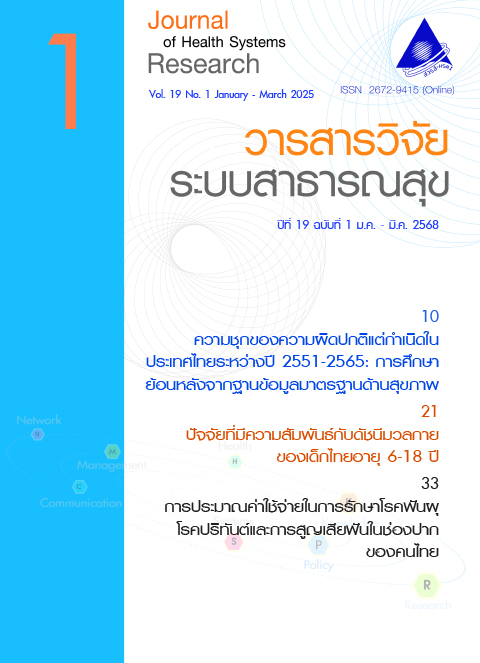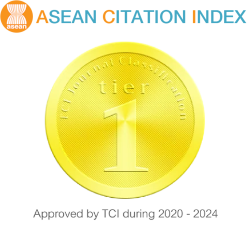Factors Associated with Body Mass Index of Thai Children Aged 6-18 Years
Keywords:
food and beverage high in fat; sugar; sodium consumption, body mass indexAbstract
Body mass index (BMI) is a critical indicator that reflects health and nutritional status and was influenced by many factors. The objective of this study was to examine the factors associated with BMI among Thai children aged 6–18 years. The data were obtained from the research project “Monitoring on Food and Beverage Marketing to Children in Thailand” which employed a stratified two-stage sampling method to select Thai children aged 6–18 years. Data collection was conducted through face-to-face interviews using the Qualtrics Offline Survey application. Ordinal logistic regression was applied to identify significant independent variables associated with overweight and obesity. The independent variables were socio-demographic characteristics of children that consisted of sex, age, education level, region, place of residence, number of children and daily pocket money for snacks and beverages, and BMI and their consumption of high fat, sodium, and sugar (HFSS) foods and beverages (categorized into 8 groups: snacks, beverages, semi-processed foods, desserts and ice-cream, bakeries, chocolate milk and yogurt, main dish, candies and gums). The results found that male, aged 10-18 years, secondary education level, daily pocket money of higher than 50 Thai Baht (THB), and consumption of sweets and ice cream were significantly associated with BMI. These results emphasize the importance of considering these factors in policy formulation and implementation to reduce BMI among Thai children. For instance, school code of controlling sales of unhealthy foods and beverages should be escalated into the law.
References
GBD 2019 Risk Factors Collaborators. Global burden of 87 risk factors in 204 countries and territories, 1990-2019: a systematic analysis for the Global Burden of Disease Study 2019. The Lancet 2020;396(10258):1223-49.
World Health Organization. Obesity and overweight. Geneva: World Health Organization; 2024 [cited 2025 Jan 10]. Available from: https://www.who.int/news-room/fact-sheets/ detail/obesity-and-overweight.
Ekplakorn V, Mo-Suwan L, Ruangdaraganon N, Satiennoppakao W, Phakcharoen H. The Fifth National Health Examination Survey 2014: child health. Nonthaburi: Health Systems Research Institute, Ministry of Public Health, Thai Health Promotion Foundation; 2014. (in Thai)
Lehmann F, Varnaccia G, Zeiher J, Lange C, Jordan S. Influencing factors of obesity in school-age children and adolescents - a systematic review of the literature in the context of obesity monitoring. J Health Monit 2020;5(Suppl 2):2-23.
Sahoo K, Sahoo B, Choudhury AK, Sofi NY, Kumar R, Bhadoria AS. Childhood obesity: causes and consequences. J Family Med Prim Care 2015;4(2):187-92.
Thongtang P, Seesawang C. Overweight conditions in Thai children. Ramathibodi Nurs J 2012;18(3):287–94. (in Thai)
No-in K. Overweight and obesity in school-aged and adolescent Thai population. RTA Nurs J 2017;18(Suppl):1–8. (in Thai)
National Statistical Office, Ministry of Digital Economy and Society. Health behavior survey of the population, 2021. Bangkok: National Statistical Office; 2021. (in Thai)
Kuźbicka K, Rachoń D. Bad eating habits as the main cause of obesity among children. Pediatr Endocrinol Diabetes Metab 2013;19(3):106-10.
Project Dek Thai Du Dee. College of Medicine, Rangsit University, editor. [cited 2025 Jan 10]. Available from: https://dekthaidoodee.rsu.ac.th/about/history?utm_source=chatgpt.com. (in Thai)
Food and Drug Administration. The display of nutritional label on food and beverage packaging. 2022 [cited 2025 Jan 10]. Available from: https://food.fda.moph.go.th/for-entrepreneurs/food-labeling-and-examples?utm. (in Thai)
Shah B, Tombeau Cost K, Fuller A, Birken CS, Anderson LN. Sex and gender differences in childhood obesity: contributing to the research agenda. BMJ Nutr Prev Health 2020;3(2):387-90.
Meejinda N, Siripromphat C, Tae-arak K. Factors associated with body mass index of students at Sirindhorn College of Public Health, Khon Kaen. Journal of Health Science and Community Public Health 2020:3(1):83–94. (in Thai)
Jindarattanaporn N, Chuenchom S, Yako K. Monitoring food and beverage marketing targeting children in Thailand. Nakhon Pathom: Institute for Population and Social Research, Mahidol University; 2024. (in Thai)
Forecast Statistics Division; National Statistical Office. Projected population by age group. Bangkok: National Statistical Office; 2023. (in Thai)
Yamane T. Statistics: an introductory analysis. New York: Harper & Row; 1973.
Cole TJ, Lobstein T. Extended international (IOTF) body mass index cut-offs for thinness, overweight and obesity. Pediatr Obes 2012;7(4):284-94.
Committee for Developing Food Classification Based on Nutritional Standards. Nutrient profile: food classification based on nutritional standards. Nonthaburi: Nutrition Division, Department of Health, Ministry of Public Health; 2022. (in Thai)
Ministry of Digital Economy and Society. Survey of food consumption behavior of the population, 2017. Bangkok: Ministry of Digital Economy and Society; 2018. (in Thai)
Hosawangwong S. Study of consumer behavior and development of instant noodles enriched with surimi and psyllium powder (Master’s thesis). Human Resources Development and Food Innovation Products, Faculty of Science and Technology. Pathum Thani: Thammasat University; 2021. (in Thai)
Yaempho S. Consumer behavior and marketing factors affecting the purchase decision of Korean instant noodles. (Master’s thesis), Faculty of Economics. Bangkok: Thammasat University; 2021. (in Thai)
Pawloski LR, Harnirattisai T, Vuthiarpa S, Curtin KM, Nguyen JT. Gender-based determinants of obesity among Thai adolescent boys and girls. Adolescents 2023;3(3):457-66.
Sukboon P, Pongcharoen T, Winichagoon P, Vongvimetee N, Khouw L, Rojroongwasinkul N. Contributing factors to nutritional status among Thai children aged 7-12.9 years - SEANUTS II Thailand. Proceedings of Asian Congress of Nutrition 2023; 2023 Sep 14–17; Chengdu, China; 2023.
Channapan Y, Anuyahong T. Health situation and factors related to body mass index among working-age population aged 15-59 years in Regional Health Area 8. In: Proceedings of the 15th National Conference on Health Promotion and Environmental Health; 2022 Jun 12-14; Udonthani: Health Promotion Center 8; 2022. (in Thai)
Guo SS, Chumlea WC. Tracking of body mass index in children in relation to overweight in adulthood. Am J Clin Nutr 1999;70(1):145S-8S.
Jebeile H, Kelly AS, O’Malley G, Baur LA. Obesity in children and adolescents: epidemiology, causes, assessment, and management. Lancet Diabetes Endocrinol 2022;10(4):351-65.
Health Knowledge Management Project through Media and Online Technology, Phyathai Foundation. Want to be healthy? You need 3 as for young children. Bangkok: Phyathai Foundation; 2015. (in Thai)
Harrison F, Jones P. Parenting and children’s dietary behaviors. J Nutr Educ Behav 2018;50(4):369-75.
Janssen I, LeBlanc AG. Systematic review of the health benefits of physical activity and fitness in school-aged children and youth. Int J Behav Nutr Phys Act 2010;7(1):40.
Pensorn K, Naphapen C, Wanpen W. Effect of a self-development program for controlling obesity in high school students in Chiang Rai Municipality. Chiang Rai Med J 2022;14(3):143-54. (in Thai)
Benson R, von Hippel PT, Lynch JL. Does more education cause lower BMI, or do lower-BMI individuals become more educated? Evidence from the National Longitudinal Survey of Youth 1979. Soc Sci Med 2018;211:370-7.
Smith J, Brown K, Lee H. Childhood obesity: socioeconomic and behavioral determinants. J Nutr Health 2023;45(3):123-34.
Bai Y, Zhang L, He C, Huang Y, Fan X, Zhang X, et al. Association of pocket money with food and beverage consumption behaviors and body mass index among Chinese children and adolescents. Int J Environ Res Public Health 2022;19(1):480.
Pismon C, Chaiapin E. Factors associated with snack and sweet beverage consumption behaviors of lower secondary school students at Ban Rai School, Nan Province. J Nurs Sci Health 2021;44(3):71–83. (in Thai)
Rahmawati DP, Indarto D, Hanim D. Correlation of snacking frequency, hemoglobin levels, physical activity, and pocket money with nutritional status in female adolescents. Med Gizi Indones 2021;16(3):207-14.
Mawarni DP, Aprilia CA, Safira L. Association between pocket money availability and frequency of fast-food consumption toward overnutrition case among junior high school students, South Jakarta. Proceeding of the 7th International Conference on Public Health; Solo, Indonesia. 2020;5(01):128-34.
World Obesity Federation. World obesity atlas 2024. London: World Obesity Federation; 2024.
Wang X, Wu Y, Yu, Z. Dietary patterns and childhood obesity: a longitudinal study. Int J Environ Res Public Health. 2023;20(6):3004.
National Health Foundation. Announcement of the Office of the Basic Education Commission on the Sale of Food and Beverages Promoting Health in Educational Institutions, B.E. 2564. (2021). (in Thai)
Jaichuen N. Food marketing communication in primary schools. Journalism. 2016;9(3):245. (in Thai)
Downloads
Published
How to Cite
Issue
Section
License
Copyright (c) 2025 Journal of Health Systems Research

This work is licensed under a Creative Commons Attribution-NonCommercial-NoDerivatives 4.0 International License.
Journal of Health Systems Research is licensed under a Creative Commons Attribution-NonCommercial-NoDerivatives 4.0 International (CC BY-NC-ND 4.0) license, unless otherwise stated.




